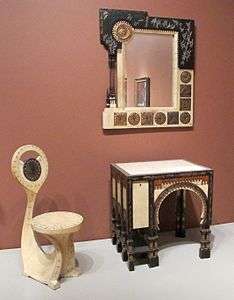Art Nouveau furniture
_(5469543414).jpg)
Furniture created in the Art Nouveau style was prominent from the late 19th century to the advent of the First World War. Unlike furniture made by the British Arts and Crafts movement, from which it emerged in stylistic respects, most Art Nouveau furniture was produced in factories by normal manufacturing techniques, which led to tensions with Arts and Crafts figures in England, who criticised continental Art Nouveau furniture for not being "'honestly' constructed.[1] It also tended to be expensive, as a fine finish, usually polished or varnished, was regarded as essential, and continental designs were usually very complex, with curving shapes that were expensive to make. It by no means entirely replaced other styles of furniture, which continued to be popular, with Art Nouveau styles largely restricted to an expensive "art furniture" category.[2] The style was named for Siegfried Bing's Maison de l'Art Nouveau gallery and shop in Paris, which opened in 1895,[3] and in France and Belgium furniture designers took up the style with more enthusiasm than those of most countries.[4]
Several notable designers were architects who designed furniture for specific buildings they had also designed, a way of working inherited from the Arts and Crafts movement; these include Charles Rennie Mackintosh, Antoni Gaudí, Hector Guimard and Victor Horta. Mackintosh's furniture was relatively austere and geometrical, marked by elongated dimensions and right-angles.[1] Continental designs were much more elaborate, often using curved shapes both in the basic shapes of the piece, and in applied decorative motifs. In many ways the old vocabulary and techniques of classic French 18th-century Rococo furniture were re-interpreted in a new style. Luxury veneers were used in the furniture of leading cabinetmakers Georges de Feure and others.[5]
Alphonse Mucha produced a few designs, but was little involved with production. The École de Nancy (School of Nancy in France), the Wiener Werkstätte in Vienna and the Deutscher Werkbund were groupings including many designers of Art Nouveau furniture.[6] The Exposition Universelle de Paris in 1900 was an important showcase for designers, and the Prima Esposizione Internazionale d'Arte Decorativa Moderna at Turin in 1902 heavily featured the work of furniture designer Carlo Bugatti of Milan.
Designers
- Gustave Serrurier-Bovy
- Josef Hoffmann
- Hector Guimard
- Émile Gallé
- Carlo Bugatti
- Eugène Vallin
- Louis Majorelle
- Henri van de Velde
Gallery
-

Chair, table and mirror by Carlo Bugatti
-
Woodwork for a dining room by Alexandre Charpentier between 1900 and 1901
-

Dawn and Dusk bed (Aube et Crépuscule) by Émile Gallé, 1904.
-
_(7979231788).jpg)
Bench by Émile Gallé, 1902.
-
Piano chair by Modernisme artist Gaspar Homar i Mezquida
Notes
| Wikimedia Commons has media related to Art Nouveau furniture. |
- 1 2 Lucie-Smith, 160
- ↑ Lucie-Smith, 160–162
- ↑ Kevin P. Rodel; Jonathan Binzen (2003). Arts & Crafts Furniture: From Classic to Contemporary. Taunton Press. pp. 87–. ISBN 978-1-56158-359-1.
- ↑ Lucie-Smith, 163–165
- ↑ Gontar, Cybele. "Art Nouveau", In Heilbrunn Timeline of Art History. New York: The Metropolitan Museum of Art, 2000–. (October 2006)
- ↑ Lucie-Smith, 161–165
References
- Lucie-Smith, Edward, Furniture, A Concise History, 1979, Thames and Hudson